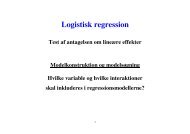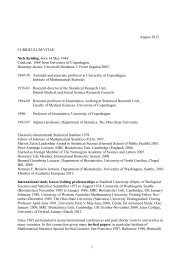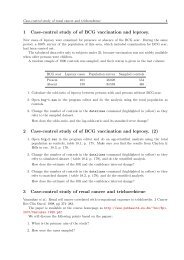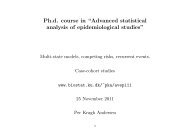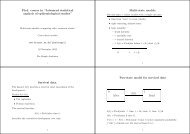Demography and epidemiology: Practical use of the Lexis diagram ...
Demography and epidemiology: Practical use of the Lexis diagram ...
Demography and epidemiology: Practical use of the Lexis diagram ...
Create successful ePaper yourself
Turn your PDF publications into a flip-book with our unique Google optimized e-Paper software.
4 4 <strong>Practical</strong> data processing<br />
time t say, will be contributions from <strong>the</strong> empirical rate (d, y) = (1, 1) with <strong>the</strong> death at<br />
time t, <strong>and</strong> all <strong>the</strong> empirical rates (d, y) = (0, 1) from all <strong>the</strong> o<strong>the</strong>r individuals that were<br />
at risk at time t. There is exactly one contribution from each individual at risk to this<br />
part <strong>of</strong> <strong>the</strong> log-likelihood:<br />
ℓt(αt, β) = � �<br />
di(αt + ηi) − e αt+ηi � = αt + ηdeath − e αt<br />
�<br />
e ηi<br />
i∈Rt<br />
where ηdeath is <strong>the</strong> linear predictor for <strong>the</strong> individual that died. The derivative w.r.t. αt<br />
is:<br />
Dαtℓ(αt, β) = 1 − e αt<br />
�<br />
i∈Rt<br />
e ηi = 0 ⇔ e αt =<br />
�<br />
1<br />
i∈Rt<br />
i∈Rt eηi<br />
If <strong>the</strong> estimate <strong>of</strong> e αt is fed back into <strong>the</strong> log-likelihood for αt, we get <strong>the</strong> pr<strong>of</strong>ile<br />
likelihood (with αt “pr<strong>of</strong>iled out”):<br />
�<br />
log �<br />
1<br />
i∈Rt eηi<br />
�<br />
� ηdeath e<br />
+ ηdeath − 1 = log �<br />
i∈Rt eηi<br />
�<br />
− 1<br />
which is <strong>the</strong> same as <strong>the</strong> contribution from time t to Cox’s partial log-likelihood.<br />
The Cox-model could <strong>the</strong>refore have been formulated as one where <strong>the</strong>re was a<br />
separate time-scale parameter for each time-interval.<br />
For those intervals on <strong>the</strong> time-scale where no deaths occur, <strong>the</strong> estimate <strong>of</strong> <strong>the</strong> αt<br />
will be −∞, <strong>and</strong> so <strong>the</strong>se intervals will not contribute to <strong>the</strong> log-likelihood.<br />
Hence, <strong>the</strong> Cox-model can be estimated by st<strong>and</strong>ard Poisson-regression-s<strong>of</strong>tware by<br />
splitting <strong>the</strong> data finely <strong>and</strong> specifying <strong>the</strong> model as having one rate parameter per time<br />
interval. The results will be <strong>the</strong> same, also for <strong>the</strong> st<strong>and</strong>ard errors, beca<strong>use</strong> it is <strong>the</strong><br />
same likelihood that is maximized. This is illustrated empirically in <strong>the</strong> first part <strong>of</strong> <strong>the</strong><br />
program lung-ex.R listed in section 9<br />
This is by no means a new discovery, already John Whitehead [4] pointed this<br />
possibility out in 1980. However, <strong>the</strong> computational capacity problems connected with<br />
this approach in <strong>the</strong> 1980s were too large for <strong>the</strong> method to catch on in practice.<br />
4 <strong>Practical</strong> data processing<br />
Implementation <strong>of</strong> <strong>the</strong> Poisson-approach in practice requires that follow-up for each<br />
individual is split in small pieces <strong>of</strong> follow-up along one or more time-scales. The<br />
relevant time-varying covariates should be computed for each interval <strong>and</strong> fixed<br />
covariates should be carried over to all intervals for a given individual.<br />
Presently <strong>the</strong>re are tools for this in:<br />
Stata: The function stsplit (part <strong>of</strong> st<strong>and</strong>ard Stata), a descendant <strong>of</strong> stlexis<br />
written by Michael Hills & David Clayton.<br />
SAS: A macro %<strong>Lexis</strong>, available at http://wwww.biostat.ku.dk/~bxc/<strong>Lexis</strong>, written<br />
by Bendix Carstensen.



